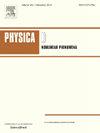具有光反馈的半导体激光器输出中时间相关性的表征
IF 2.9
3区 数学
Q1 MATHEMATICS, APPLIED
引用次数: 0
摘要
本文对具有光反馈的半导体激光器的动力学进行了实验研究。我们使用两种基于事件的方法来表征发射强度的时间序列,一种基于阈值交叉定义的事件(我们将此方法称为峰值分析),另一种基于低于阈值的强度最小值定义的事件(我们将此方法称为峰值分析)。通过对连续事件之间的时间间隔序列进行序数分析,我们确定了事件时间的时间相关性,这些时间相关性随用于定义事件的方法以及实验控制参数、激光泵电流和反馈强度而变化。尖峰分析定义的事件通常比峰值分析定义的事件慢(它们的频率取决于实验条件,通常分别为≈10 MHz和≈1 GHz)。我们表明,用于定义强度时间序列中的事件的两种方法提供了动态的互补表征。我们还发现,使用这两种方法和在广泛的参数区域,有序概率被组织成由具有相似值的概率对组成的簇。我们提出了三种诊断工具来分析有序概率的聚类。本文章由计算机程序翻译,如有差异,请以英文原文为准。
Characterizing temporal correlations in the output of a semiconductor laser with optical feedback
We perform an experimental study of the dynamics of a semiconductor laser with optical feedback. We use two event-based methods to characterize the time series of the emitted intensity, one based on events that are defined by threshold-crossings (we refer to this method as spikes analysis), and the other one on events that are defined by intensity minima that are below a threshold (we refer to this method as peak analysis). By applying ordinal analysis to sequences of time intervals between consecutive events, we identify temporal correlations in the timing of the events that vary with the method used to define the events, as well as with the experimental control parameters, the laser pump current and feedback strength. The events defined by spike analysis are usually slower than those defined by peak analysis (their frequencies depend on the experimental conditions and are typically MHz and GHz respectively). We show that the two methods used to define events in the intensity time series provide a complementary characterization of the dynamics. We also find, with the two methods and in broad parameter regions, that the ordinal probabilities are organized in clusters formed by pairs of probabilities with similar values. We propose three diagnostic tools to analyze the clustering of the ordinal probabilities.
求助全文
通过发布文献求助,成功后即可免费获取论文全文。
去求助
来源期刊

Physica D: Nonlinear Phenomena
物理-物理:数学物理
CiteScore
7.30
自引率
7.50%
发文量
213
审稿时长
65 days
期刊介绍:
Physica D (Nonlinear Phenomena) publishes research and review articles reporting on experimental and theoretical works, techniques and ideas that advance the understanding of nonlinear phenomena. Topics encompass wave motion in physical, chemical and biological systems; physical or biological phenomena governed by nonlinear field equations, including hydrodynamics and turbulence; pattern formation and cooperative phenomena; instability, bifurcations, chaos, and space-time disorder; integrable/Hamiltonian systems; asymptotic analysis and, more generally, mathematical methods for nonlinear systems.
 求助内容:
求助内容: 应助结果提醒方式:
应助结果提醒方式:


